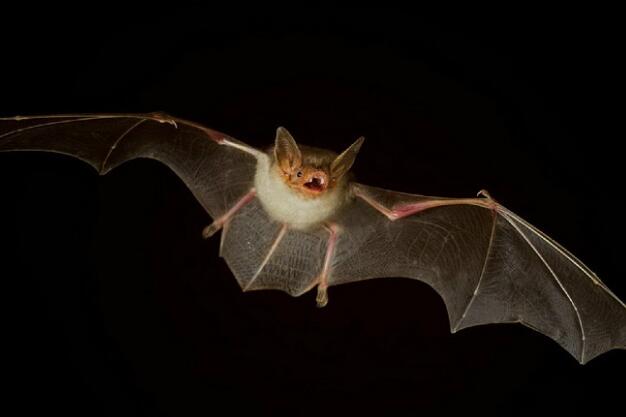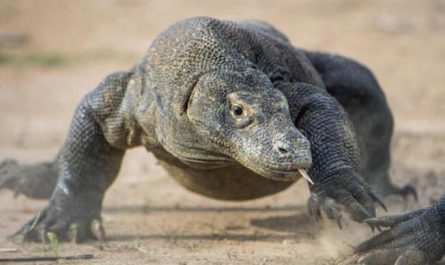The reason why bats can catch food at night
Bats have poor eyesight, but they prefer to come out in the evening to catch mosquitoes, and their speed and accuracy of preying are amazing. Scientists have discovered that the bat’s hunting skills do not rely on its eyes, but rely on its “echo detection” ability. Someone once blindfolded a bat and placed it in a large glass room with many wires. It still avoided the wire barrier and accurately caught insects. It turns out that the echo detection system in the bat’s body is very clever. When it is flying, it generates ultrasonic waves from the throat and emits it through the mouth or nose. When it encounters objects, the ultrasonic waves are reflected back. The bat’s ears receive the echo, which can accurately identify the external environment and hunt down insects that move at night. What’s even more amazing is that the bat’s ultrasonic detection system can accurately distinguish the properties of objects.
For example, some people experimented to throw away flour worms and metal scraps together, and blindfolded bats can accurately distinguish the nature of the two things, and only prey on flour worms and ignore the metal scraps. The bat’s echo detection system also has the characteristics of fast frequency and strong anti-interference ability. It is conceivable that when a bat catches food, it often finds a target while flying, and sometimes it can suddenly change its original flight direction within a fraction of a second and quickly chase the prey. According to calculations, bats can emit and receive (resolve) 250 groups of echoes in one second. In addition, the bat’s echo detection system can eliminate human interference, and is not afraid of mutual influence between the same species. In the caves where hundreds of bats live, they emit ultrasonic waves at the same time, still doing their own things. The radar developed by scientists based on the principle of “echo detection” of bats has been widely used, and the sensitivity and anti-jamming capabilities of radars have been continuously improved. People also imitated the “echo detection” system of bats and made “sonar glasses” and “pathfinders for the blind” for night military reconnaissance and use by the blind.
The habits of bats
People often use the term “birds and beasts” to describe birds and beasts, but this statement is sometimes not correct, because some birds can’t fly, such as ostrich, emu, kiwi and penguin; There are also some beasts that do not walk, such as cetaceans that live in the ocean, while bats do not walk on the ground like ordinary terrestrial beasts, but can fly in the air like birds. Certain species of bats are masters of flight. They can turn around very quickly in narrow places. Bats are the only mammals that can flap their wings. Other flying mammals, such as flying squirrels, just glide in the air by their wing-shaped skin. ! At night, bats find their way and hunt by sound waves. They emit sound waves that humans cannot hear. When this sound wave encounters an object, it will return like an echo, so the bat can distinguish whether the object is moving or stationary, and how far away it is. Long-eared bats prey on insects in flight, and it can also catch insects from leaves. Its big ears enable it to receive echoes.
Bats are the only beasts that can really fly. Although they do not have the feathers and wings of birds, and their flying ability is much worse than that of birds, their forelimbs are very developed. The upper arms, forearms, metacarpal bones, and phalanges are very long. A thin and hairy layer of soft and tough skin from the end of the phalanx to the humerus, side of the body, hind limbs and tail forms the unique flying organ of bats—winged hands. There are also records about bats in ancient China that they also live in stalactite caves, called fairy mice. Bats there can drink water from the cave to get longevity. After thousands of years, their body colors have also changed dramatically. The dark color turned into white all over, which is probably why they are called fairy rats.
Bats use waves to determine whether there are obstacles ahead and use this to change the flight path. In the past, many people said that bats had poor eyesight, but it was actually a big mistake. Many scientists have pointed out that the eyesight of bats is not bad, and that different kinds of bats have different eyesight. The use of ultrasound in bats is not necessarily related to their eyesight.
Natural enemy
The main natural enemies of burrowing bats are snakes and lizards; the natural enemies of arboreal (some fruit bats) are also some raptors and cats. Other natural enemies of bats are humans. For example, the Guam bat was extinct because of predation by the locals.
feeding habits
Bats have a wide range of food habits. Some species like nectar and fruits, while others like to eat fish, frogs, insects, suck animal blood, and even eat other bats. Generally speaking, big bats generally feed on fruit or nectar, while most small bats feed mainly on insects.
There are various types of bats that eat: fruits, fish, pollen, and even blood. Most bats prey on insects while flying at night, and each bat can distinguish its own sound waves, which means that even if it preys with other bats, it will not be disturbed by other sound waves.
Bats that feed on insects have echolocation systems to varying degrees, so they are called “live radar”. With this system, they can fly and catch food in a completely dark environment, use echolocation under a lot of interference, and send out wave signals without affecting normal breathing. The snouts and noses of their heads have structures called “nose lobes”, and there are also very complicated special skin folds around them. This is a peculiar biological wave device that can emit waves. Continuously emit high-frequency biological waves. If you encounter obstacles or flying insects, these biological waves can be reflected back, and then received by their extraordinary large auricles, so that the feedback information can be analyzed in their tiny brains. This kind of biological wave detection sensitivity and resolution are extremely high, so that they can not only distinguish the direction according to the echo, locate their own flight path, but also distinguish different insects or obstacles to effectively avoid or hunt. Bats rely on accurate echolocation and extremely soft membranes to hover freely in the air. They can even fly with dexterous curves and constantly change the direction of waves to prevent insects from interfering with its information system and attempting to escape.
Hibernation habits
Bats generally have the habit of hibernation. Most hibernation places are in caves. During hibernation, their metabolism is reduced, breathing and heartbeat are only a few times per minute, blood flow slows down, and body temperature drops to the same temperature as the environment, but hibernation It is not deep, sometimes it will excrete and eat during hibernation, and it will return to normal immediately after waking up. Their fertility is not high, and there is a phenomenon of “delayed fertilization”, that is, fertilization does not occur during mating before hibernation, and the sperm spends winter in the female reproductive tract. It is only after waking up in the following spring that the mated female begins to ovulate and Fertilization, pregnancy, and birth.
surroundings
Bats live in various large and small caves, cracks, ceilings, partition walls, tree caves, and rock crevices in ancient buildings. Some southern fruit-eating bats also hide behind the leaves of palm and banana trees. Some bat populations have thousands of bats together, some male and female bats live together, and some live separately. Many bats living in the woods migrate to warm areas in winter, sometimes flying thousands of miles. Temperate cave bats generally hibernate. Bats breed only once a year, and in the earlier warm season, bats produce cubs.
Precipice Tracking
Hidden in the mountain in the southeastern part of Guangxi Zhuang Autonomous Region is a mysterious cliff with thousands of bats. The locals call it Flying Squirrel Rock. It is said that there are more than 10 million bats. Zhang Libiao, Ph.D. of Zoology, Chinese Academy of Sciences, led a team to Feishuyan for field research, hoping to reveal the secret of bats adapting to the environment through research on local bats. The bats on Flying Squirrel Rock can move on a large scale in an orderly manner, and the superior terrain of Flying Squirrel Rock forms a natural barrier for bats to avoid predators of raptors. Every September, all the bats on Flying Squirrel Rock disappear. Zhang Libiao believes that this is because the mouth of Flying Squirrel Rock is large and the temperature in winter is unstable. The bats must move to a warm place to hibernate and overwinter physiological state.
Bats vary greatly in size. The largest flying fox has a wingspan of 1.5 meters, while Kitty’s pig-nosed bat has a wingspan of only 15 cm. The color, fur texture and facial appearance of bats also vary greatly. The bat’s wings evolved from the forelimbs during evolution. Except for the thumb, the fingers of the forelimbs are extremely stretched, and there is a flying membrane from the forearm and upper arm down to the side of the body to the ankle of the lower limb. There are claws at the end of the thumb.
Most bats also have a two-layer membrane between their legs, consisting of dark, bare skin. The snout of a bat resembles a rodent or a fox. The outer ear protrudes forward and is usually very large and flexible. Many bats also have nasal lobes, which are made of skin and connective tissue, which surround or flap above the nostril. It is believed that the nasal lobe affects vocalization and echolocation.
The pectoral muscles of bats are very developed, the breastbone has keel protrusions, and the clavicle is also very developed. These are all related to its special movement mode. It is very good at flying, but it needs to rely on gliding when taking off, once it falls to the ground, it is difficult to fly again. Extend the hind legs back when flying to play a balance role.
Bats have short necks; hips and legs are long and thin. Except for the wing membrane, bats have hair all over the body, the back is in shades of gray, brown, brown or black, and the ventral side is lighter. Bats that inhabit open areas often have spots or variegated patches on their fur in a natural order, with different colors. Bats have different feeding habits, or are predatory, or help to pollinate and spread fruit, thereby affecting the natural order. Vampire bats are a serious problem for humans. The dung of insectivorous bats has been used as fertilizer in agriculture.
Bat growth and reproduction
The sexual cycle of the entire bat colony is synchronized, so most of the mating activity occurs within a few weeks. The gestation period is from 6 to 7 weeks to 5 to 6 months. Many types of females move to a special breeding habitat after pregnancy. Bats usually give birth to 1 to 4 litters. The cubs are hairless or less hairy when they are born, and often cannot see or hear for a period of time. The cubs are taken care of by the parents for 5 weeks to 5 months, depending on the type.
Almost all bats rest during the day and search for food at night. This habit allows them to invade sleeping prey without being harmed by other animals or high temperature light.
Bats usually like to live in isolated places, such as caves, crevices, burrows or buildings, and they also live on trees and rocks. They always hang upside down and rest. They generally gather in groups, ranging from dozens to hundreds of thousands. Bats with echolocation capabilities can produce short, high-frequency sound pulses, which are reflected back when they encounter nearby objects.
Bats hear the reflected echo and can determine the location and size of prey and obstacles. This ability requires the close integration of highly sensitive ears and vocal centers with auditory centers. Individual bats may also communicate in the form of sound pulses.
A small number of bats rely on smell and vision to find food. There is a mouth that emits ultrasonic waves with a full frequency of 20,000 Hz. Objects will be reflected into the ears, and nerves will be transmitted to the brain at a speed of more than 300 kilometers per second to make judgments.
Although they have wings, they look a lot like birds. But they have no feathers or lay eggs. They have the characteristics of mammals: females give birth to pups and feed them with milk.






